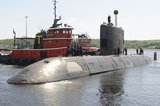Third Singaporean LMV launches
Singapore Technologies Marine (ST Marine) has launched the third Littoral Mission Vessel (LMV) for the Republic of Singapore Navy (RSN), Unity, the company announced on 13 October.
ST Marine received the contract to design and build eight LMVs for the RSN from the country's Ministry of Defence in 2013. Delivery of the vessels is expected to begin from 2016, with the vessels becoming fully operational by 2020. The LMVs will replace the Fearless-class patrol vessels that ST Marine designed and built in the 1990s.
The first LMV, Independence is currently undergoing its checkout, integration and testing phase for weapon systems on-board.
The second LMV, Sovereignty, will be entering sea trials soon, while the third LMV, Unity will embark on harbour acceptance trials shortly.
The LMVs are 80m long and are designed to operate in confined and congested littoral waters. The vessels can be configured with mission modules for various operations.
More from Naval Warfare
-
![How will SAFE shape naval procurement for Canada and its highest-receiving members?]()
How will SAFE shape naval procurement for Canada and its highest-receiving members?
Canada’s inclusion on the EU’s Security Action for Europe initiative is set to enhance the country’s defence procurement strategy with important implications for some of its naval programmes, while Poland and Romania have also secured significant SAFE funding.
-
![Thales wins DE&S contract for portable autonomous command centres]()
Thales wins DE&S contract for portable autonomous command centres
The agreement to provide portable autonomous command centres to the UK Royal Navy will enhance the service’s Mine Counter Measure operations and further integrate autonomous and uncrewed systems into its fleet.
-
![US Navy to conduct an experimentation campaign with emerging tech in 2026 and 2027]()
US Navy to conduct an experimentation campaign with emerging tech in 2026 and 2027
The Technology Operational Experimentation Events will inform future requirements as the US Navy looks for innovative solutions across three key operational domains.





















